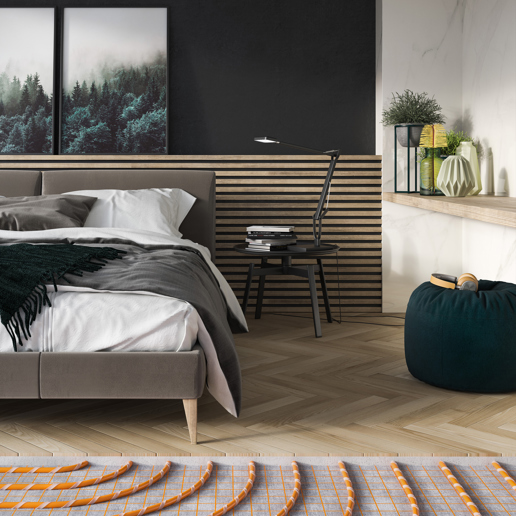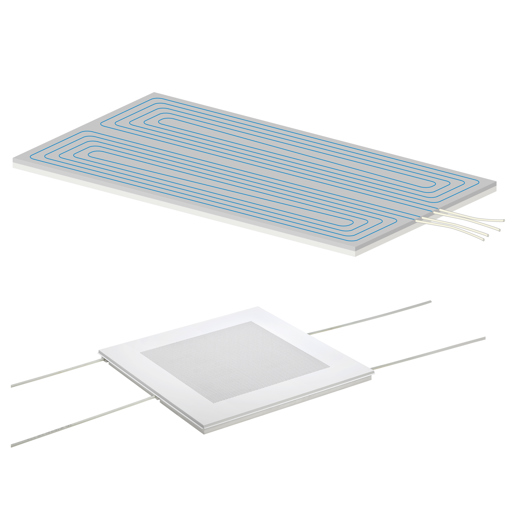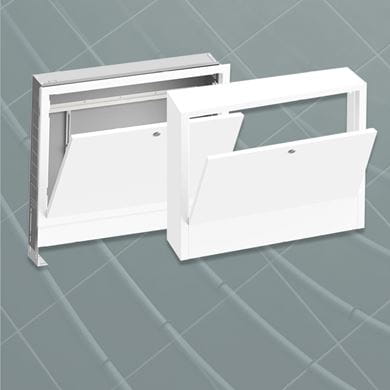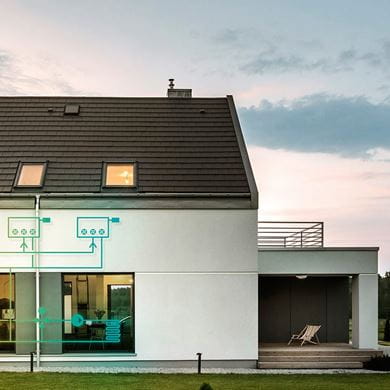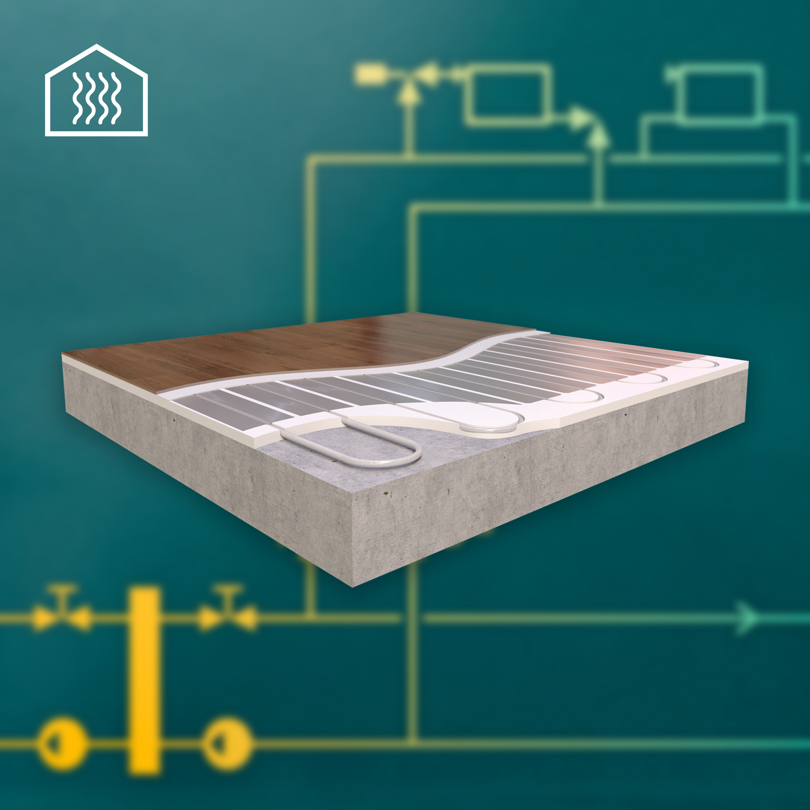
Underfloor heating
Underfloor heating is a popular and common radiant heating and cooling variant for an alternative to radiator based systems, but there are other solutions such as wall and ceiling systems to consider.
A radiant heating and cooling system includes pipes, manifolds, cabinets, mixing units, dehumidifiers for radiant cooling also with other accessories and options.
We also offer design support for planning a radiant system installation.
About underfloor heating systems
The ins and outs of underfloor heating
For most users, underfloor heating is about creating a high level of comfort thanks to the even spread of warmth underfoot. However, underfloor heating has many advantages, such as a high energy efficiency thanks to low operating temperatures and a great versatility in use. So whether it’s for private housing or for commercial buildings, our underfloor heating systems are able to provide the perfect indoor climate comfort solution.
Comfort squared
When talking about comfort with regard to underfloor heating, we of course refer to thermal comfort, but there’s more. While the even heat distribution ensures a pleasant ambient temperature and avoids cold spots across large areas, underfloor heating also ensures a high design comfort as it eliminates the need to find space for a hydronic or electric radiator. This way architects and designers have absolute flexibility in furniture and fixture arrangement. On top of that, the heating system can also provide underfloor cooling to guarantee a comfortable indoor climate all year round.
Energy-efficient underfloor heating
Since underfloor heating systems are highly efficient in the way they circulate the heat, they can run at much lower temperatures and therefore yield significant energy savings. This not only decreases operating costs, but also has a positive effect on our energy use and can be further enhanced by connecting the underfloor heating system to a heat pump for optimal use of renewable energy.
Versatile heating solution
Thanks to its versatility, the underfloor heating we offer at Purmo can be used almost anywhere. Houses and apartments as well as churches, sports halls and industrial buildings, for example, can benefit from the pleasant heating system that provides heat exactly where it’s needed and prevents heat loss. Moreover, our underfloor heating systems are compatible with many types of flooring so you can effortlessly combine style and functionality.
-
1. Is underfloor heating more expensive than radiators?
In principle, it can be assumed that the purchase costs are comparable to those of radiators. However, when it comes to renovation, there may be variations depending on the extent of the project. Radiators make it possible to replace only the old radiators, without the need to interfere with the building structure.
Installing underfloor heating can result in higher costs during the renovation phase, as the floor must be replaced. In return, operating costs are somewhat lower as underfloor heating systems operate on a low-temperature system.
In a direct price comparison between underfloor heating and radiator heating, it must be taken into account that underfloor heating and insulation are usually included in the system price. This is not the case for heating systems using radiators. However, in order to find the best solution for your needs, it is important to always keep in mind the entire initial situation and user behaviour when choosing a specific system or a combination of different systems. -
2. Is it advisable to install underfloor heating under carpet or parquet?
Floor heating can be used without any problems under carpets, parquets, etc. However, there are a few factors to consider. Firstly, it should be ensured that the floor covering has the lowest possible RD value (thermal resistance). Floor coverings with a high RD value insulate the underfloor heating and reduce system efficiency. Secondly, the floor coverings should be approved by the manufacturer for use on underfloor heating systems and the maximum permissible surface temperatures should be observed, particularly for parquets. -
3. Is underfloor heating better than radiator heating?
It is not possible to provide a definitive answer to the question of whether underfloor heating or the use of radiators is better. The answer always depends on the area of use, requirements and habits of your users. Radiators deliver high heat output quickly and promptly, which facilitates rapid and cosy temperature control of rooms. By contrast, underfloor heating systems operate with continuous, consistent heat output at low system temperatures. In order to find an optimum solution, it is necessary to clarify all factors in advance and incorporate them into the planning of a new heating system. -
4. How does underfloor heating work?
The heating system technology is similar to that of radiators, with the difference that heating water is not fed to the radiators, but flows through the pipes of the underfloor heating systems. The heat exchangers are mainly located in the floor. The systems are now also installed in the wall or ceiling. In contrast to radiator heating, underfloor heating uses a low supply temperature (between 30 and 35°C), which results in a high level of energy efficiency. -
5. Can you operate underfloor heating with wooden floors?
Underfloor heating systems can easily be used under wooden floors. In contrast to other floor coverings, however, a few special points should be observed here. On the one hand, wood has a higher thermal resistance than tiles, for example. This should be compensated for in the design by using a slightly higher system temperature or a narrower installation spacing. Furthermore, wood can contain a certain amount of moisture, which may cause it to move. For this reason, seasoned wood that is suitable for use with underfloor heating should be used. When installing, please always observe the manufacturer’s specifications regarding the application area of the flooring. -
6. Can underfloor heating replace radiators?
Whether an underfloor heating system can replace radiators depends on the application requirements. In a conventional renovation, where only the heat exchanger is to be replaced without adapting the building structure, it is difficult to switch to underfloor heating, as the heat output of underfloor heating and the available options for underfloor installation are limited. Nowadays, however, there are special renovation systems that provide high heat output levels with very low installation heights.
It goes without saying that underfloor heating systems can be used instead of radiators in new buildings. The user behaviour, the structural design of the building and the selected system technology must be taken into account in the planning. -
7. Does underfloor heating require a lot of electricity?
When using hydraulic or hydronic underfloor heating systems, no more electricity is required than for radiators in the system. The only components that use electricity are the control technology components, such as the room thermostat and the actuators for temperature control. -
8. Is underfloor heating gas or electric?
Underfloor heating systems are hydraulic (using hot water) or electric. In heating systems, gas refers to the design of the heat generator that heats the water in hydraulic systems. Heat generators can be operated with gas, oil, solid fuels or as heat pumps. Due to the low system temperatures, a heating system with a heat pump is now recommended for underfloor heating systems. Warm water flows through the floor heating elements themselves and the heat is dissipated to the rooms via the floor.
Entirely electric systems are possible, but are only used to a limited extent. During installation, the electrical planning must be dimensioned and tested accordingly with all necessary fuses and connection sizes. -
10. Can you install underfloor heating with laminate flooring? Can underfloor heating systems be used with laminate flooring?
Underfloor heating systems can be used in combination with laminate flooring. There is only one restriction in the system selection. All wet systems can be used with laminate floors. For dry systems, it is important to ensure the necessary load balance over the laid surface. Therefore, when using the combination of dry system with laminate flooring, an additional load balancing layer (Strongboard, Fermacell) is required. -
10. Why does the floor not feel warm even with underfloor heating?
Today, buildings have an average heating load of approx. 30-50 W/m2. During the entire heating season, the average heating load is approx. 10-20 W/m2. In order for underfloor heating to provide maximum performance at a room temperature of 20°C, for example, it only needs to heat the floor to 23-25°C (i.e. to 21-22°C on average). If you touch this floor with your hand (hand temperature approx. 35°C), it feels "cold" in comparison to radiators (surface temperature approx. 50°C). This low floor temperature is therefore not a defect in the system, but is absolutely sufficient to warm up the room comfortably.

